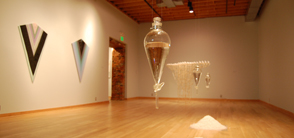There has been only one day in the last 13 years that Waymond Harrison hasn’t painted: the day he got out of prison.
In the eight months since his release, Harrison has spent most of his time in a small shed nestled in the woodsy backyard of a sage green house. His studio is busy with blown-up reference photos of Malcolm X, metal canisters filled with bubblegum-pink water and brushes, and a painting in process on nearly every wall. While the space is roomier than his prison cell, a new influx of mosquitoes has forced the 43-year-old to shield himself with long track pants and citronella candles.
Harrison developed his artistic style — a mix of Picasso’s portraiture and Basquiat’s expressionism — using materials from the Maryland Correctional Institution of Jessup. His first exhibition, titled “LIFE,” examines how every choice can alter your path — and how his decision to prioritize self-love changed his entire future.
Harrison, who is reworking one of the pieces from the collection, sits in a chair, bending down over a banner from the prison print shop splayed out on the floor. He’s concentrating on the artwork’s water-based paint that splintered during a cold winter in the shed. He goes over the previous strokes with oil paints to fix the scene — an all-white jury that saw him sentenced in 2012 to 36 years on charges including possession of firearms, narcotics with intent to distribute, and drug trafficking. At the bottom, “NOT MY PEERS” is written in all-caps.
Harrison’s exit from prison felt surreal and sudden. By 2024, the painter, now sober and focused, had accepted his sentence. But his aging parents, who traveled hundreds of miles every few months from North Carolina to see him, wanted to spend time with him on the outside. They asked if there was anything else he could do.
His new, randomly chosen lawyer happened to know about One Promise, a recovery house with which Harrison’s judge was familiar. Harrison went to court on a Wednesday and was out that Friday.
He knows how lucky he was. “I’m honoring that with my actions,” he said. Harrison starts his day at 3:30 a.m. “This has been my routine since I’ve been home: work out twice, create, go to sleep, repeat,” he said.
The only de viation is counseling with One Promise. Just three months into the drug program, he now works as a house manager for others on the sobriety journey.
The strict adherence to his daily schedule exemplifies the discipline that got Harrison sober eight years into his last sentence. He said the Jessup prison was rife with a drug referred to as K2, a form of synthetic marijuana. It gradually took a toll on Harrison’s physical and mental health.
The prison did not respond to multiple requests for comment. But Harrison said a correctional officer there was the reason he stopped using.
“He was like, ‘Man, you know, you got a lot of talent. You need to stop … this shit can kill you,’” Harrison recalled. “And while he was telling me this, I had a pocket full of it.”
As he sat in his bunk to roll a joint, Harrison suddenly took his stash and flushed it down the toilet. In the five years since, he said he hasn’t touched alcohol, cigarettes or drugs — vices that gripped him for decades.
Harrison’s main expenses now are paint and Uber rides. He’s surrounded by his favorite books, supportive people and, of course, his paintings.
But when Harrison was growing up, he said, “I wasn’t even aware of art.”
Harrison’s first incarceration was in sixth grade. He was 12 years old.
“I’m selling drugs at 11, that was my existence up until my 30s,” Harrison said. After more than a quarter century in and out of prisons, art became a way for him to understand his circumstances.
“I had to paint it out of my system,” he said.
Harrison filled his bunk with “anything that wasn’t nailed down” from the print shop, paints from an older man who saw Harrison borrowing stacks of art history books from the library, and materials he ordered semiannually from the prison catalog. He was inspired by everything from Virgil Abloh’s fashion designs to Architectural Digest magazines and, when he found sobriety, the philosophies from “Siddhartha” and “The Master Key System” books.
Harrison said a prison counselor told him, “Your positivity is toxic.” His sober attitude was so changed, some thought it was fake.
Not so, Harrison said. “Love became my foundation, this unconditional love, because I did so many bad things throughout my life that the pendulum just swung.”
He continued to paint every day — reading books about art and self-mastery — and even painted murals around the prison. “I was focused on my craft, and that’s it,” he said. Harrison was no longer painting things out of his system; he was painting for an audience.
The “LIFE” collection, which became the basis of his first gallery exhibition at the Hotel Indigo this spring, grew from Harrison’s personal story. While incarcerated, he said he took over the prison art program and taught his cell neighbor how to paint, a favor that would be repaid when they were both released. The fellow inmate introduced him to Linda Keeley, the founder and current trustee of the Redistribute Agency & Wealth Fund — a 501(c) that aims to decolonize wealth and help Black communities self-organize.
Keely said meeting Harrison “felt really fortuitous.” She bought one of his pieces, “Bag Lady,” for the youth organization AZIZA PE&CE. Though Harrison told her, “I don’t know why I painted this one,” Keely said the artwork spoke directly to the Black girls and LGBTQIA+ youths at the organization.
Keely then introduced Harrison to Amy Cavanaugh, director of Maryland Art Place. It was that group’s IMPACT program that gave Harrison his first exhibition. Since then, he’s worked with BLFTD Art Studio’s visiting artists collection to showcase his works.
“Growing his own interest in art and having that supported by the prison system, I think, is pretty unique and special,” Keely said. “He just used what he had available.”
It’s been quite the journey for someone whose goal is to be “one of the biggest and most successful artists in the world.”
Before getting sober, he said, “I had no idea of what I wanted to do, who I wanted to be.” But painting changed everything. “I know it’s cliche, but that shit really saved my life.”
“I was at a point where every little thing mattered. Every choice mattered — even every thought could evolve and become positive,” he said.
The collection, featuring the word “LIFE” in bold white letters on a red backdrop worked into each piece, was also a way to spark meaningful conversations with other inmates.
“I felt like the only way I could make people think about life was to just litter a painting or a canvas with it,” Harrison said.



.jpg)
.png)
.png)
